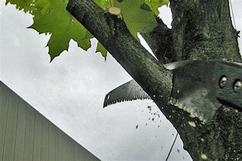How to Prune a Tree
Pruning a tree is one of the most usual tree care practice you can regularly do to your trees. Here are the reasons why to prune, how to prune, and when to prune a tree.
Reasons to Prune a Tree
A tree will need to be pruned for a variety of reasons:
After deciding the purpose(s) for pruning the tree, the next contemplation is to do it yourself or hire a professional. With large, mature trees, where big branches will need to be cut and safely lowered to the ground, it is always best to hire a tree care expert. Further, large trees may require them to be climbed in order to cut them efficiently and effectively. Any climbing should, again, be left up to the professionals. However, if you can reach all the upper branches of a smaller tree while keeping both feet firmly planted on the ground then DIY pruning is an option.
- to eliminate damaged for diseased branches
- to reduce the crown, or top of the tree, to allow for better air circulation and new growth
- to reduce the tree's height
- to remove lower branches that are a source of interference
- to re-shape or shape a tree for landscaping aesthetics
After deciding the purpose(s) for pruning the tree, the next contemplation is to do it yourself or hire a professional. With large, mature trees, where big branches will need to be cut and safely lowered to the ground, it is always best to hire a tree care expert. Further, large trees may require them to be climbed in order to cut them efficiently and effectively. Any climbing should, again, be left up to the professionals. However, if you can reach all the upper branches of a smaller tree while keeping both feet firmly planted on the ground then DIY pruning is an option.
How to Prune

Whether a tree is small or large, the goal of pruning is to eliminate unwanted growth while protecting the trunk of the tree. Tree growth always starts from the stems and pruning must always occur to the branch-side of the stem node. Stems and branches are separated by a tissue lip known as the stem collar, which grows from the stem near the base of the limb. All cuts must be made on the branch side of this collar. Doing so protects the other branches and stem that would otherwise grow from it. It also permits the tree to heal more quickly and effectively after pruning. If cutting larger branches, to prevent tearing of the stem wood and trunk bark, consider the following three steps.
- Make a wedge cut on the underside of the branch to the branch side of the collar. This cut will cause the bark to break at the cut's point preventing it from tearing down into more bark and stem tissue
- Now, farther down the branch, begin at the top of the limb, and cut all the way through the limb leaving a stub end.
- Lastly, make a final cut just on the branch side of the stem collar and parallel to it to minimize the length of the stub as much as feasible.
Should I Seal the Wound?
Trees will naturally seal over their wounds when a limb is removed; therefore, the wounds should be allowed to close on their own. And since pruning should be done in the winter or late fall, insects and other pests won't be a problem With that said, in some situations, it is advisable to seal the would with a latex-based pruning sealer. Specifically, birch, elm, and oak trees can be susceptible to insect infestation if those conditions are possible. Further, if the weather is unusually dry, a sealer will aid in helping the tree retain moisture.
When to Prune
The dormant seasons for most trees is the ideal time to prune, which is late fall or winter. Dead branches can be removed at any time of the year. Further, if the limbs are completely frozen due to extremely cold weather then pruning is not advisable. Lastly, it is a good practice to apply a light fertilizing around the tree so that when the growing season occurs, the tree is in a better position to naturally close the pruning wounds.
Call Allentown Tree Service for professional tree pruning services.
